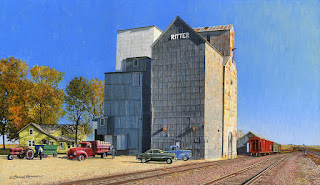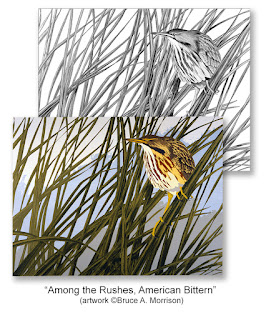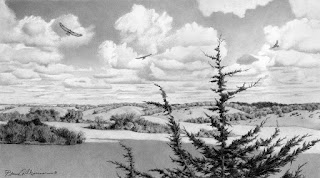Do you enjoy the sights, sounds, smell, and touch of the Prairie? How often do you wish you were once again standing on sites of past years; revisiting those memories, as clear as the day they were first formed? Do you want to experience new Prairie locales; the flora, fauna, and life events, and heritage? Join us on the Tallgrass for something we've been missing during the hustle of our daily activities...if this sounds like your "cup of tea", join us and enjoy the view!
Friday, February 25, 2022
Archived Works Friday - No. 5!
Friday, February 18, 2022
Archived Works Friday - No.4!
Saturday, February 12, 2022
Archived Works Friday! (Uh...Saturday!)
Tuesday, February 8, 2022
Prairie Landscapes and Birds - in the Studio and Our World
 | |||
| "Stream Side Autumn Ashes" - color pencil drawing - © Bruce A. Morrison |
After so much time spent rebuilding web sites - I've finally been spending time trying to be productive in the studio. I've managed to tick off some ideas that have been on my to-do list...mostly color pencil works, although I'm also working on an oil at the present as well.
One landscape is of some Ashes along the Waterman Creek, just south of us about 5-6 miles. I remember the ashes being in good autumn color - these trees always seem to be one of the earlier trees to turn around here and I've often lamented that it's also one of the more abundant hard woods around here - with Emerald Ash Bore only a breeze away now, soon they'll just be a memory...
This was a fun piece to work on, kind of a struggle at times to give the ash leaves the luminosity I wanted, but all in all - the piece worked out satisfactorily. And autumn is probably my favorite season! It was fun doing a pleasant autumn day in our valley while warm and toasty inside during some frigid winter days! ("Stream Side - Autumn Ashes" - color pencil drawing - © Bruce A. Morrison )
 | ||
|
This one is a little different...more of a foreground subject with a slight bokeh to the background (more out of focus). I wanted to cast more interest and color contrast on the sunflowers and let the focal interest decline behind them. I may have spent too much time trying to delineate the type of sunflowers though...they are meant to be “Showy Sunflowers”...or as some call them “Prairie Sunflowers”...the scientific name would be “Helianthus pauciflorus “. I found it a bit daunting getting the leaves the way I wanted...should have drawn them before drawing in the background...its hard controlling color pencil when drawing over previously sketched areas...so spent a lot of time on damage control. These sunflowers have been known to hybridize with other types, so all this can get confusing! I'll just call 'em “Prairie Sunflowers” and let it go at that. (“Prairie Sunflowers” - color pencil - ©Bruce A. Morrison)
 | ||
|
I just recently finished the White-Breasted Nuthatch "portrait"...these are a favorite from the early years - actually the first bird I ever photographed up close - with my first SLR and telephoto lens...back in 1963. Winter days always seem more uplifting with the pleasant nasal calling of these little guys...they're one of the friendliest yard birds as well - often still on the feeder when bringing new seed for the day, seemingly unconcerned with my presence. I portrayed this one “head down” as they are typically seen climbing up and down tree trunks and on the bird feeders! (“White-breasted Nuthatch – Portrait” - color pencil drawing - ©Bruce A. Morrison)
 | |
| "Bobolink – Portrait” - color pencil drawing - ©Bruce A. Morrison |
The
last (but not least!) bird is my prairie favorite - the Bobolink! My
father remembers them on the farm in the late 1920's and early 30's
as the "Spink-spank-spink" bird. I get a kick out of their
call and antics; a birding friend mentioned he thought they sounded
like R2D2. Ha! He's right!
When we first came here 20 years
ago, I found Bobolinks along several pastures...these birds are on
the list of grassland obligates in most trouble in North America. I
have been concerned with their situation for many years, and watched
their local populations in the "neighborhood" with
interest. Slowly I have noted nesting pairs disappearing in local
pastures.
We've always had Bobolinks in our south pasture...until last year. We share this pasture with a neighbor and last year they took out their fenceline bordering their crop ground and plowed into their edge to gain more ground and eliminate the weed issues the fence was creating, but then they went into the pasture even more. The small pasture apparently lost too much size and the birds never returned.
"Our" pair disappeared last year but we still had a pair directly across the road to keep their song and antics still in view. The pasture across the road had never been mowed/hayed before the 4th of July since we've been here (now 20 years). I always appreciated that! Not only does that protect nesting birds like Song Sparrows, Common Yellow-throats, Meadow Larks, Sedge Wrens, Dickcissels, and many others - but it also protected Bobolinks.
Bobolinks are curiously different birds - they are early arrivals - often
around the same time the Pasque Flowers bloom on the prairie slopes.
They get right down to pairing up, setting up their territories and
nesting. And they only nest "once" a season. Their young
hatch in late spring and fledge quickly. So many are lost to
haying...if their nests don't remain unmolested till around the first
of July - they are usually lost. Once they have fledged, they gather
with other birds and resemble "nomads" through the middle
of summer - traveling around in small flocks until heading out for
their winter homes in South America.
Sadly, last summer the
pasture across the road from us was mowed early...mid June. We
watched hopelessly as the adult male could be seen flying around in
the spot it's nest had once been. We don't know how the female fared?
The male left after a couple days...their nesting season was done.
Will this or another pair return to that pasture next year? It is
certain their progeny won't. Gradually, bit by bit this scenario
plays out across their nesting range. They are grassland obligates -
in need of conservation practices. Sure, there are still pastures or
small grasslands in the region that still support Bobolinks, but that
does not negate the fact they are noticeably vanishing from there
former ranges. I am still "sincerely" hoping that a pair
will return here for another chance...
I read last year that
Bobolink numbers have become so low in New England states that in
Maryland some regional farmers are being given a stipend or payment
for not haying before July. I don't know much about this effort or
what other plans (if any) are being considered to help this bird
remain on its former nesting sites for the future? I don't want to
sound alarmist, but I am concerned, and so are conservationists and
ornithologists familiar with the well documented decline in our
grassland birds.
I realize that our birds are all in decline,
recent reports from the past couple years are not promising. I'd like
to believe that we can still do something, but being a small witness
to this firsthand is hard on this old birder's heart.
(“Bobolink
– Portrait” -
color pencil drawing - ©Bruce A. Morrison)
It's still February but much warmer than usual and very dry...we've only had two snows this winter and the last one is about 50-60% gone. It makes for better farm chores for sure but we are still in a drought here...I sure hope March and April bring good rains!
Be kind to one another and hope to see you on the Tallgrass!
Saturday, February 5, 2022
Archived Works Friday!



